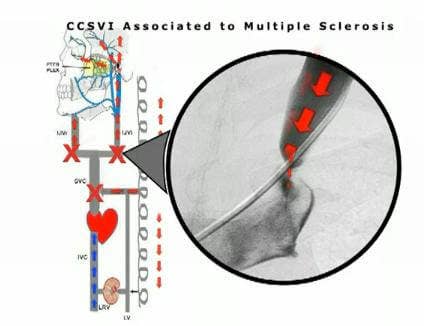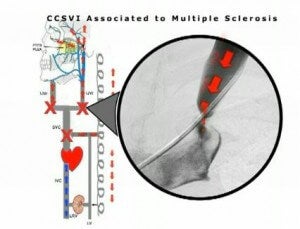Cautious Optimism in Response to ‘Cure’ For Multiple Sclerosis

Share

Holy Crap! There could be a cure for Multiple Sclerosis (MS)! Even more remarkable, this cure could be coming from outside of the established MS research community. There isn't agreement on the exact nature and cause of MS, but an Italian doctor, Paolo Zamboni from the University of Ferrara, has developed a theory and provided a possible treatment. Zamboni believes that most cases are caused by the build up of iron due to restricted blood flow in veins. This proposed condition, Chronic Cerebrospinal Venous Insufficiency (CCSVI), turns accepted MS theory on its head. Yet of the 65 patients Zamboni treated 73% have lived for more than two years without symptoms. Check out Zamboni's explanation video, and a Canadian news segment on his work, after the break.
MS is a debilitating condition where the myelin sheath on nerves is slowly destroyed. Lesions (aka scleroses) form in the brain and spinal cord. During regular relapses, and over time, patients lose muscle control and neurological function. In short, MS is awful. MS is commonly regarded as an autoimmune disease with a strong genetic bias. Zamboni essentially proposes that it is a vascular disease that can be corrected fairly easily. As with angioplasty, CCSVI is treated by inserting a balloon or metal stent into a blocked vein (typically the jugular or azygos). This corrects blood flow and MS symptoms just seem to melt away. While this appears to be miraculous news for the 2.5 million sufferers world wide, the MS Society of Canada is calling for more tests and research before supporting the CCSVI theory. The National MS Society in the US acknowledges that more research is needed but encourages its members not to get tested for CCSVI or seek vascular surgery. Still, online forum discussions on the CCSVI-MS connection are rampant, and many are clamoring for surgical trials in North America.
Be Part of the Future
Sign up to receive top stories about groundbreaking technologies and visionary thinkers from SingularityHub.


My own skepticism about CCSVI is partially augmented by a remarkable coincidence around Zamboni's discoveries. First, his wife Elena Ravalli began to suffer from MS in 1995. This inspired Zamboni to research the disease. Zamboni is a vascular surgeon and he just so happens to discover that MS is a vascular condition with a surgical cure. I ask myself, if an orthopedic surgeon had a spouse who developed MS, would the cure for MS magically be a bone graft?
Still, it's hard to argue with Zamboni's results. Using Doppler ultrasound techniques and MRI scans, he found that 90% of MS patients had deformations or damage (called strictures) to the veins draining blood from the brain. Doctors have long noted that MS patients have higher levels of iron deposits in the brain. Zamboni proposes that these deposits are not a by-product, but a key cause of MS. By opening venous strictures, he believes that iron is able to be removed from the brain and spine. 65 patients were treated by Zamboni's team and showed remarkable improvements. Active scleroses for the group dropped from 50% to 12%, and 73% of patients had no MS symptoms after two years. Mrs. Ravalli has gone more than three years without a MS relapse.
As wonderful as these cures may appear, there is much more research to be done. 65 patients is a very small sample set. To that end, Dr. Bianca Weinstock-Guttman at SUNY Buffalo, and Dr. Mark Haacke at McMaster University in Hamilton are each pursuing separate verification of Zamboni's work. SUNY is actively seeking 1700 adults and children (with and without MS) for studies in blood flow and iron levels using MRI and ultrasound. Haacke, a renowned expert in imaging, is requesting patients to send him MRI scans.
It's still much too early to know if Zamboni's CCSVI theory will be proven correct, or if there will ever be a proven surgical cure for MS. Yet the Italian doctor's work gives hope to all of us who want to live longer and healthier. Diseases with unknown causes are the unpredictable roadblocks on the path of life. The sooner that each can be understood and cured the better all of our chances will be to live forever. Even if you're not into the whole immortality game, work like Zamboni's shows that given the right conditions, researchers may find completely new solutions to the problems that plague our friends and families. That's good news for everyone.
[screen capture credit: Paolo Zamboni]
[video credit: Paolo Zamboni, CTV M5]
Related Articles

Refreshing the Brain’s Immune Cells Could Treat a Host of Diseases

Your ChatGPT Habit Could Depend on Nuclear Power

Time Doesn’t Really Flow—Your Brain Just Makes You Think It Does
What we’re reading